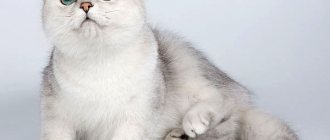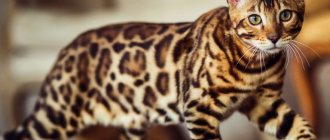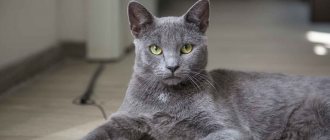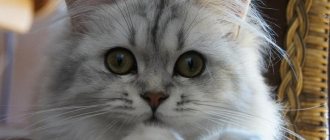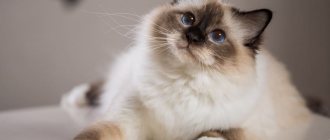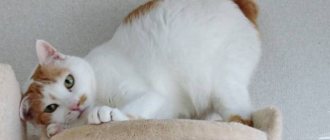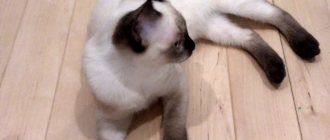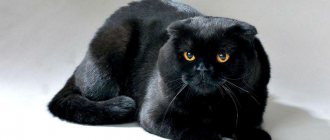The small domestic leopard is a Bengal cat, born as a result of crossing Asian wild and common domestic cats. These cats are quite friendly and peaceful, but do not forget about their opposite side.
This is the first moment that you will have to face when raising a small animal - Bengals have a difficult character, so you will need to find an approach to it, and you need to do this exclusively with affection and love.
The Bengal cat is not too large, the height at the withers is on average 32 cm, weight is about 7 kg, females are slightly smaller. The body is strong, muscular, slightly elongated. The limbs are elongated and strong.
These cats perfectly combine the features of a domestic cat and a wild cat; they are smart, cunning, careful, very active and graceful. Some may think that they are too unsociable, but this is not entirely true. They are wary of new people and watch from some hiding place, but they show enough attention and affection to their owners.
Bengals are quite friendly with all family members and can find a common language with other animals, but you should know that this cat needs its own territory, which it will consider as its own and protect, satisfying its natural instincts.
This breed is distinguished from others by its love of conversation. Bengals, unlike their counterparts, love to talk with people, and they do this in various ways: along with simple meowing, they use a lot of other sounds.
Socialization of kittens
Knowing how to raise a Bengal kitten, you will never encounter his aggression. It is when hunting that the tailed “child” can be sharp (he is excellent at catching mice). But the pet will get accustomed to the family pretty quickly. Interestingly, raising such a cat is not particularly difficult. These creatures are very smart and observant, so they learn many useful skills from people with interest.
Socialization of the kitten takes place without unnecessary problems. True, the animal, as a rule, treats family members, including children, differently (more precisely, the cat chooses one owner). A pet can watch its pet for hours, it does not like to let it out of its sight.
Vaccinations
We give you a kitten only after full vaccination. But this does not mean that it is never necessary to vaccinate it again. Revaccination with a complex vaccine is carried out annually. It must be done one year after the last vaccination. The dates of vaccination are noted in the veterinary passport (we also give it away along with the kitten). It is important to remember this and vaccinate on time.
Now on the issue of rabies vaccination. It has been scientifically proven and confirmed by protocols all over the world that immunity from rabies persists for three years after vaccination. But in our country, the old protocol is still used, according to which rabies vaccination remains annual.
THE MOST IMPORTANT!!!! Never self-medicate or receive treatment over the Internet. If your pet feels unwell, becomes lethargic, refuses to eat, or has diarrhea, then you MUST contact a veterinary clinic.
Character
Keeping Bengals in enclosures leads to their rapid wilding. But in a pack they feel great. If it is possible to take two kittens, this will be a good option for them. The Bengal cat, contrary to rumors, is not aggressive or even bloodthirsty. He gets along well with children and poses no danger to them. Only rodents and birds should be afraid of it.
When raising small Bengal kittens, it is necessary to accustom them to handling from the first day. Then they will become affectionate friends, but otherwise wild animals.
These cats are quite smart and quick-witted. They easily learn to open doors and even flush the toilet. Like their wild cousins, Bengals have a special love for water. However, this does not mean that they swim in the bathtub, or even dive. They like running water. In this case, you can watch the splashes and catch them with your paw.
Cats of this breed become very attached to their owner and become dependent on humans. They love to engage in conversations, as they have a fairly wide range of different sounds in their arsenal.
Another interesting character trait of Bengals is their love of water. Animals of this breed, contrary to prejudices that cats are afraid of moisture, enjoy swimming and taking baths.
If a Bengal cat has to get into a fight, its behavior is different from other breeds. Bengals do not rush at the enemy head-on, but wait for the moment when he turns his back to him, and pounce from behind - an echo of wild origin.
Representatives of this breed have a lot of advantages, but it is worth understanding that it is impossible to accurately state and attribute any character traits to all Bengal cats. Each animal is unique, but some advantages specific to this particular breed can still be highlighted.
- Lack of aggressiveness and contact. As a rule, Bengals get along well with children and get along well with other pets.
- Adequacy and intelligence. Bengal cats rarely get into fights with stronger opponents. They prefer to avoid such clashes.
- Love of bathing. Owners will have no problems if the need arises to bathe their pet.
- Courage. Bengal cats actively guard and defend their territory from strangers. These animals are difficult to scare.
- Ability to learn. Animals of this breed are very capable, they can even be taught some tricks (for example, flushing the toilet or turning off the light in the room).
- Good qualities of mousecatchers. Hunting instincts play a good role when fighting rodents.
Speaking about shortcomings, we can say that they arise from character strengths.
- The animal's activity allows it to be playful, but at the same time, left alone for a long time, the Bengal can make a big mess.
- Attachment to the owner makes the Bengal cat a loyal friend, but the animal is not able to remain alone for a long time and does not tolerate when the owner does not have time for him.
- The independence of cats makes them not entirely tame. Bengals love to be on an equal footing with humans, but they don't particularly like being cuddled or picked up frequently.
Contact
Representatives of the Bengal breed are very sociable and curious. They will explore every available corner. Any thing within their reach will sooner or later become a toy. Therefore, your new child should have HIS OWN toys! They love everything rustling and buzzing.
Bengal needs to expend a lot of energy. It’s good if this spending is organized, i.e. You must take part in this. Play “hide and seek around the corner”, go for a run. Make a toy like a fishing rod (on a meter-long stick there is a meter-long rope with something rustling) and chase the cat for at least half an hour, but with minute breaks (cats are sprinters, not marathon runners).
Your Bengal will be grateful to you, you will see for yourself how his affection will increase. The more games, the less trouble. In your absence, everything will remain intact, because they will be waiting for you.
Talk to the animal, come up with your own commands. Use the word “cannot”. Many breeders use a water pistol for educational purposes; the method is not bad, but is not always available in various circumstances. At first, the word “no” can be used in conjunction with pinching the neck. Young animals already know this sign - this is how their mother raised them, and all you have to do is continue what you started. Never use violence towards cats (except in cases of treatment and emergency confinement), this will undermine trust in you, and it is important for a cat to trust you for a comfortable, happy and healthy existence.
It is not uncommon for owners of one Bengal cat or cat to decide to get another Bengal. This is one of the opportunities to take care of your unusual pet, because it is the sociable nature of these cats that brings fun to those around them. Without a doubt, they will become even happier and share even more positive things with you.
Feeding
Keeping adult Bengal cats is, first of all, a balanced diet. Not many owners of cats of this breed feed them natural products. It is recommended to give preference to dry food mixtures, which should be purchased in pet stores, but not in supermarkets. Such formulations not only contain various vitamins in the required quantities, but also carefully care for the health of your pet’s gums and teeth.
Kittens do not always digest dry food well (some may even develop allergies). In this case, buy wet food (canned food). If you switched your Bengal cat to exclusively natural products, make sure that the animal receives not only food, but also vitamins. Oats or chalk - your pet will chew all this with pleasure.
Related article: Common and rare diseases of British cats
Catering rules
Until the age of one month, babies, as a rule, are fed only breast milk. After 4–5 weeks, new foods begin to be introduced into the diet. This could be a scraped chicken breast, scalded with boiling water. A little later it will be veal, beef or turkey cut into small pieces. Add porridge with eggs to your diet. Be sure to include raw and boiled vegetables: carrots, pumpkin, beets, broccoli, cauliflower.
Keep in mind that at the age of 8–9 months, a cat’s weak point is the stomach (diarrhea often occurs). Experts recommend feeding animals very carefully and choosing premium food:
- Husse;
- Grandorf;
- Acana;
- Royal Canin;
- Orijen;
- Fitmin (grain-free).
The packaging must indicate that the food is intended for feeding kittens. Pay attention to the age recommendations on the packaging. Some kittens have individual intolerances and skin allergies - in this case, purchase hypoallergenic formulations.
Consider the physical activity of Bengals. For neutered cats with a tendency to obesity, low-calorie recipes are suitable. Try not to give such economical options as Felix and Whiskas.
There should always be fresh water in the bowl, which should be changed 1-2 times a day.
What proponents of natural nutrition should know:
- 80% of the diet should be meat, the best option is beef without fat.
- 10–15% – edible bones: neck, joints, cartilage (except tubular).
- 5–10% – tripe: chicken heart, stomach, lung.
- You can also give chicken, rabbit, and veal as meat.
- The meat is first frozen and served raw.
- You can sometimes feed them boiled pieces.
- Liver is given rarely and little by little.
- Pork and lamb are prohibited for Bengals.
- You cannot offer hot or cold food.
- Cats are given boiled, boneless sea fish; cats do not need fish.
- Healthy dairy products include kefir, fermented baked milk, and cream.
To breed “little leopards” and have healthy offspring, take care of vitamins and minerals. A veterinarian will help you make the right choice.
What dry food should you pamper your pet with?
Ready-made food is considered a more balanced food. But they also have disadvantages.
| Advantages | Flaws |
|
|
However, most of the disadvantages are inherent exclusively in cheap options. More expensive ones contain high-quality products, vitamins and various nutritional components.
Feed is divided into 4 groups based on quality:
- Economy class: “Kitekat”, “Whiskas”.
- Premium class: “Hills”, “Bozita”, “Royal Canin Bengal Adult”,
- Super-premium class: “Arden Grange”, “Cimiao”, “1st Choice”, “Chicopee adult cat”.
- Holistic: “Orijen”, “WildCat Etosha”, “Chicken Soup”, “Acana”, “CARNILOVE Salmon for Adult Cats – Sensitive & Long Hair”, “Eukanuba Adult with Chicken”
Food for Bengals should not have a fat content higher than 20%.
Small carnivores have very sensitive digestive systems, so the best choice for them would be a holistic diet. Let's take a closer look at some options from this group.
- "WildCat Etosha": good composition with a vitamin complex. Contains a lot of protein, while there are no cereals. The only drawback is the price - 3 kg costs 2,400 rubles.
- “Eukanuba Adult with Chicken”: optimal protein content for Bengals. It also has a good composition, but contains wheat, which contributes to the rapid weight gain of the cat. Price - 4416 rubles per 10 kg.
- "Orijen": fish is used as a source of proteins and fats. But legumes are responsible for carbohydrates, which are not recommended for Bengal cats. But it contains a large amount of vitamins and probiotics, which have a good effect on intestinal flora. Price for 5.4 kg - 3999 rubles.
Take a responsible approach to the decision to purchase food: this breed has a hard time with a change in diet. It’s better to check with the breeder what the domestic leopard ate and according to what diet.
You cannot mix food of different manufacturers and consistencies in one meal.
If you want to diversify your pet's diet, it is recommended to give wet food. But choose the same manufacturer and product line. Maintain the proportion: 75% of the daily requirement is dry food, the rest is wet. For show cats, use the 50/50 formula.
Make sure your cat always has clean water at room temperature.
Care
Providing complete care for a breed called a Bengal cat is a whole set of recommendations that need to be taken into account. Knowing how to care for a Bengal kitten from a young age, you will not worry about the health of your pet in the future (for example, the risk of allergies will noticeably decrease). What rules are required to be followed?
Behind the ears
Care and maintenance of your Bengal begins with regular cleaning of the ears. They often accumulate dust and sulfur, which must be removed in a timely manner. To do this, use ear sticks that are pre-moistened in a special solution. Do this procedure regularly, and the health of your Bengal's ears will be in perfect order.
Behind the wool
Many people strive to breed such cats because of their main advantage - the stunningly beautiful color of their coat. But what’s interesting is that special coat care is not required. It is enough to purchase special cosmetics that will give the fur smoothness and shine. Every few days, use a rubber or metal comb to run through your Bengal's coat.
However, you don’t need to comb it too often - the pet’s fur is short, and it rarely sheds.
Behind the teeth
In order for the breeding of these cats to be successful, it is very important to be able to provide proper care for them. Pay special attention to the dental health of your Bengal cats. They do not require special cleaning. The main thing is not to skimp on products. If you purchase high-quality feed mixtures, then nothing will threaten your dental health.
Behind the claws
First of all, buy a special scratching post. It is necessary because the Bengal cat loves to sharpen its claws. If this is not done, she will find another alternative that is not very pleasant for you (a soft sofa or chair, wallpaper or carpet). Therefore, having a scratching post is mandatory from the moment a kitten appears in your apartment. Another important point in caring for your nails: trim them once a week. To do this, it is advisable to use a special nail clipper.
Similar article: How to organize food for a kitten and an adult Maine Coon
Safety
All animals love fresh air, so an interest in windows is inevitable. The safety precautions here are the same as with children. Follow!
If your window opens obliquely, you need a canopy over the gap and on the sides. Otherwise, the animal may get stuck there and die.
Most Bengals love heights. Safe places for climbing are necessary, otherwise those that are available - shelves, cabinets, chandeliers - will be used.
Build or buy a complex for your pet, but higher. It’s good if the last shelf is right under the ceiling. Then you will see a proud forest animal contemplating its territory.
It is necessary to remove electrical wires (under the baseboard, in boxes). Here, of course, it’s possible, but I’m in favor of cleaning everything up.
Try to keep the floors clean, because there is all the dust there, and the animal's breath is so close to it.
In nature, protect your animal from ticks by applying the product to the withers. It’s better not to let him walk in tall grass (that’s where parasites live).
To walk on a leash, use a reliable, comfortable harness; later, when the animal grows up and learns to obey, you can use a collar; it is easier to put on and does not restrict movement.
On hot days, the animal needs access to drinking water. Can't stand it!
Never leave an animal unattended in a car.
At the age of 4 to 8 months, an animal purchased not for breeding must be castrated; this simple operation will keep him joy and happiness for the rest of his life. Remember that a sexually mature male or female cat can run away from home during the “hunt”, can be aggressive and suffer a lot!
If you want to breed Bengal cats, we offer free assistance from our nursery (organization of mating with a suitable manufacturer, consultations, a page on the website, photo sessions, assistance in selling kittens).
To do this, choose a Bengal kitten for breeding with us. Choose a kitten
Origin of the breed
The Asian leopard cat, the Bengal, has the grace and flexibility characteristic of many predators. External features of a purebred pet:
- Wedge-shaped head with a large chin.
- Wide nose, slightly curved.
- Very beautiful almond-shaped eyes. Color – golden or rich green.
- Chubby cheeks with attractive pads.
- The ears are set high and short in size with a noticeable rounding at the tips.
- Muscular long neck.
- Strong body of large size.
- Small tail, fairly dense structure.
- Powerful paws, rounded at the base. The forelimbs are slightly shorter in length than the hind legs.
- Soft silky coat, hypoallergenic, short length with a shiny sheen. Thick in texture with dense undercoat. Has no tendency to shed.
The cat of this breed is large and quite impressive in size. Females reach 5 kg, the average weight of males is 7 kg. The coat color of Bengal cats can be any shade, with the exception of aquamarine and blue.
Mandatory condition for color: uniform distribution of distinct oval-shaped spots throughout the body of the animal, black or dark brown. The exception is the black Bengal cat, which has uniformly colored charcoal-colored fur.
The most popular coat colors for Bengals are:
- leopard, spotted;
- rosette on gold - golden coat color with brownish spots;
- marbled color, has spots on the coat, but with an unusual distribution and non-standard shape;
- rosette on silver - wool with a silver tint and dark spots;
- snow leopard is gray and white with dark spots (the snow Bengal cat is born pure white, and over time characteristic spots appear on the body).
An interesting variety of the breed is the fold-eared Bengal cat, whose appearance is somewhat reminiscent of a Scotsman. It is of natural leopard origin, but instead of having short ears with rounded tips, representatives of this variety have the tips of their ears drooping, creating an unusual appearance.
Bengals have an interesting character. Some consider this breed to be aggressive, associating the domestic cat with predators, but this is not the case. In fact, the pet’s character contains only good traits. Bengal cats are affectionate and friendly, loving attention and care.
They have a well-developed hunting instinct and intelligence. Cats will never go where it might be dangerous. In this they are helped by developed precautions and incredible intelligence.
Bengal cats are very loyal to their owners and quickly get used to their home environment. A cute pet often behaves like a faithful and devoted dog, follows on the heels of its owner and rejoices like a child if the owner shows attention and care.
Purebred kittens are very playful and active, and even as they grow up, they continue to show an active character and enthusiastically spend time in outdoor games with other family members. If there are other pets in the house, the Bengal will quickly make friends with the “neighbor”. They are not afraid of dogs and easily build friendly relationships even with dogs of fighting breeds.
Bengal cats love heights. They will happily nestle on the top shelf of the closet and watch what is happening in the house from above. But they need a high position not only as an observation point. For Bengals, such a platform is an excellent place for jumping.
If you do not want to catch interior items from the top shelves of furniture items, try to remove everything valuable and fragile from visible places, since during active jumping the cat can catch things standing nearby. These disadvantages of the animal's character are easily eliminated by proper upbringing.
Better yet, buy a special installation with a ladder for your pet. It will replace not only the empty cabinet shelves in the house, but also the curtains and curtains that the Belgian representative loves to ride on.
Reading this description of the Bengal breed, many begin to give up the idea of having a leopard pet because of its restless nature. But there is no need to get scared ahead of time. This breed is distinguished by its unsurpassed intelligence and intelligence, so proper upbringing can teach the kitten good manners. They can be trained and taught different commands. An intelligent and loyal cat will be happy to carry out the owner’s instructions and learn new tricks.
Bengal cats inherited from their predatory descendants a love of water and bathing. This quality is unusual for domestic cats, who are wary of such procedures. With a Bengal, everything is much simpler; the cute pet will happily sit next to the water tap and play with the flowing liquid. Bathing is successful, the pet loves to swim in the bath and splash in the water with its beloved owner.
If you do not want to share the bathing procedure with your pet cat, close the bathroom door while bathing, as a cat of this breed will jump into your water without hesitation. Well, they can’t resist such pleasure!
Bengal cats love attention and do not tolerate loneliness well. It is not recommended to have such an animal for busy people who do not have the opportunity to devote enough time and attention to their pet. This is an interesting characteristic of Bengal cats.
The domestic Bengal cat was bred in the second half of the last century. We owe the appearance of this artificial breed to the American geneticist biologist Jean Mill. This persistent woman spent two decades before she was able to demonstrate her handiwork at the TICA Championship. On this long journey there were successes, failures, and a long break in work.
The first individuals bred were cautious, distrustful, and did not make contact. They preferred a solitary lifestyle, although they did not show aggression. More than once, Jean Mill brought wild representatives of the original breed from the southeast of the Asian continent or took wild representatives of the original breed from the zoo and crossed them with domestic cats. The first was the female Malaysia, then the Bengal cat Delhi and so on. Gradually, patience and perseverance revealed to the world a gentle miracle in a leopard fur coat.
Nowadays, the already popular breed is becoming more and more in demand. People come to the Bengal nursery and learn about the nature of the charming animals, their care, and nutrition. An important issue is also resolved here - the price of a Bengal cat.
How to educate and toilet train
Raising these feline babies is an important process for their owner. First of all, the kitten needs to be toilet trained. This is not always easy to do, since these creatures are so squeamish that they sometimes refuse to even visit their litter box. To avoid this problem, buy wood filler for the toilet. If even after this the “Bengal” does not want to go to the litter box and relieves himself in another place, sprinkle the surface with table vinegar or citrus fruits, and your pet will not appear there again.
Raising your tailed pet is simply necessary. Spend more time with him as he has a very playful personality. It is important that the “Bengali” has his own toys, otherwise he will catch and start having fun with everything he comes across, right down to your clothes.
Remember: it is necessary to teach the cat the “No!” command in a timely manner.
To do this, first combine a verbal command with lightly pinching the kitten's neck. However, do not try to hit him - violence will not help your pet understand what you want from him. When walking, try to put a harness around the cat's neck. You need to accustom him to a leash from an early age, then he will not behave nervously during walks.
Content Features
Adult cats do not cause their owner unnecessary trouble. All that is needed is timely vaccination and feeding, as well as the love of the owner. Be sure to install a scratching post in your apartment. From their ancestors, these creatures inherited long and sharp claws that need to be sharpened periodically. These are real athletes who cannot sit idle, so in a small apartment a frisky kitten can ruin all the curtains by swinging on them. It is much better if he has the opportunity to play outdoors and hunt birds.
But there is no need to wash and comb these cats. These are very clean creatures that carefully lick themselves, even if you lightly touch their fur, which is short and shiny. By the way, it has one feature - it changes color depending on the lighting. In the bright sun, the fur shines, shimmers and shines. These are very elegant cats that people like. They are very active and inquisitive.
Common diseases and vaccinations
Adult Bengal cats are prone to diseases. Most often they present with diseases associated with the gastrointestinal tract. However, the list of common ailments also includes cardiomyopathy and flat chest syndrome. Allergies are no exception for Bengalis. To reduce the risk of developing certain diseases, do not neglect vaccinating your pet. The first vaccination is done in the nursery.
Your main task is to adhere to the vaccination schedule in the future. Remember: any disease can be detected at an early stage, which means you can get rid of it sooner. Bring your Bengal cat to the veterinarian for a check-up at least once a year. At the first symptoms, a specialist will provide the animal with the necessary medical care.
Related Article: Overview of the Celtic or European Shorthair Cat Breed
Video “What you need to know about the Bengal cat”
From this video you will learn about how the Bengal cat breed appeared, how to care for and feed it.
Recommended Posts
Standard height and weight of the Cane Corso breed by month
Weight of a puppy and an adult Labrador by month
Description and content of the hunting border terrier
Weight and height of a German Shepherd puppy by month
Description and care of the highly intelligent Border Collie breed
Description of forms and features of treatment of enteritis in cats
Intelligence
When talking about the features and character of Bengal cats, it is important to note their intelligence. Representatives of this breed have the instincts and cunning of their predatory ancestors, the highest adaptability, intelligence and intelligence. Bengals are very attentive and observant, capable, like dogs, of remembering and following commands.
This domestic cat with the appearance of a mini-leopard very sensitively captures all the nuances of the owner’s mood and strives with all her might to correct him, attracting him to her pranks and games.

